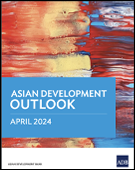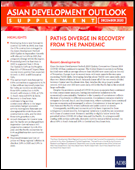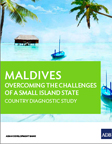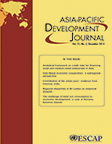 Asian Development Outlook (ADO) April 2024Robust growth is forecast for South Asia in fiscal year (FY) 2024, driven by strong gains in investments, consumption, and the electronics and services sectors. Gross domestic product (GDP) is estimated at 6.3% in FY2024 and 6.6% in FY2025 in South Asia. In Bangladesh, GDP growth is projected at 6.1% in FY2024 behind the growth of traditional low-end garments. Bhutan's projected GDP is at 4.4% given major developments in the country's hydropower sector. In India, GDP is forecast at 7.0% in FY2024, after a strong momentum in manufacturing and services in FY2023 and with exports expected to pick up in FY2025 with the rise in global growth. Growth in Maldives is estimated at 5.4% in FY2024 supported by tourism and construction. Nepal is estimated to grow at 3.6% backed by hydroelectric production and domestic demand. Amid recovery efforts in Sri Lanka, modest growth at 1.9% is forecast for the country in FY2024. In Southeast Asia, Myanmar’s GDP is projected to remain low at 1.2%. Author: Asian Development Bank Year: 2024 Download Tags: South Asia, ADB, Hydropower, Tourism, Bangladesh, Bhutan, India, Maldives, Myanmar, Nepal, Sri Lanka Open for Business: How Maldives Overcame the COVID-19 CrisisThe economy of Maldives, being reliant on tourism, went into recession due to border closures and travel restrictions during the coronavirus (COVID-19) pandemic. The pandemic called attention to the need for Maldives to diversify its economy to reduce short-term macroeconomic volatility. In addition, Maldives stands to benefit from setting up regional maritime connectivity for strengthening food trade with other South Asian countries. Author: Abdulla Ali, Elisabetta Gentile, Macrina Mallari, Thiam Hee Ng Year: 2023 Download Tags: ADB, Tourism, COVID-19, Maldives Leveraging Thematic Circuits for BIMSTEC Tourism DevelopmentThematic tourist circuits in the BIMSTEC region can help boost economic recovery from the pandemic and promote a return to pre-COVID-19 tourism growth. However, to fully realize the benefits of cross-border tourism and create thematic circuits, multiple issues need to be addressed throughout the region. This report focuses on COVID-19 recovery, infrastructure, marketing and products, human resources, policy, and investment areas, and recommends actions for each to help hasten the recovery and aid in creating thematic circuits. Author: Asian Development Bank Year: 2022 Download Tags: BIMSTEC, Tourism, COVID-19 Beyond the Pandemic: Building Back Better from Crises in Asia and the PacificThe coronavirus disease (COVID-19) pandemic has interrupted trade and tourism worldwide, leading to job losses and rising poverty. Countries need to address weaknesses in economic and social protection systems, through national initiatives that can be supported by regional cooperation. United Nations Economic and Social Commission for Asia and the Pacific member countries endorsed the Action Plan to Strengthen Regional Cooperation on Social Protection in Asia and the Pacific. This provides a platform through which governments in South Asia could work together to help mitigate the impacts of the pandemic. Author: United Nations Economic and Social Commission for Asia and the Pacific Year: 2021 Download Tags: COVID-19, Regional Cooperation, South Asia, Trade, Tourism Asian Development Outlook (ADO) 2021 Supplement: Renewed Outbreaks and Divergent RecoveriesGrowth forecast for South Asia has been downgraded to 8.9% for 2021, dampened by new surges of coronavirus disease (COVID-19) infections. Growth in exports and remittances backed economic activity in Bangladesh. In Bhutan, economic activity has slowed after local containment measures were enacted to control the spread of COVID-19. India's growth projection has been downgraded to 10.0% from 11.0% in 2021. Weak travel demand in Maldives and persistent infections in Nepal are hampering recovery in those countries. In Sri Lanka, restrictions brought about by a third wave of infections are slowing down tourism and other economic activity. With businesses and consumers in South Asia better able to adapt to containment measures, the adverse economic impact of COVID-19 surges is expected to be limited. Author: Asian Development Bank Year: 2021 Download Tags: COVID-19, Tourism, South Asia  Asian Development Outlook (ADO) 2020 Supplement: Paths Diverge in Recovery from the PandemicThis publication provides updated economic forecasts for Asia and the Pacific. In South Asia, the earlier forecast of 6.8% contraction in 2020 is upgraded to 6.1%. Growth in South Asia is expected to return in 2021 at 7.2%. This is in line with improved prospects for India, where contraction is projected at 8.0% in 2020 and growth is projected at 8.0% in 2021. In Bangladesh, growth in exports and remittances backed economic activity. In Bhutan, the impact of the coronavirus disease (COVID-19) pandemic is expected to be greater than projected. Travel demand remains weak in Maldives and is hampering recovery. In Nepal, a persistent rise in COVID-19 infections holds back demand. Resurgent outbreaks in Sri Lanka’s export and tourist markets are expected to worsen contraction in 2020. Author: Asian Development Bank Year: 2020 Download Tags: South Asia, India, Bhutan, Sri Lanka, Nepal, Bangladesh, Maldives, Tourism, COVID-19, Export Asian Development Outlook (ADO) 2020: What Drives Innovation in Asia?Growth in developing Asia is forecast to slow to 2.2% in fiscal year (FY) 2020 due to the effects of the global health emergency. In South Asia, growth will decelerate to 4.1% in FY2020 and rebound to 6.0% in FY2021 following a projected revival in India. Bangladesh is projected to grow by 7.8% this fiscal year and 8.0% in FY2021. GDP growth in Bhutan, despite lower tourist arrivals, will accelerate on high government spending. Growth in Maldives and Sri Lanka will be constrained this year due to weaker tourism. In Nepal, the outlook is for moderating growth. In Southeast Asia, Myanmar growth is expected to slow in FY2020 and pick up in FY2021. Author: Asian Development Bank Year: 2020 Download Tags: ADB, Bangladesh, Bhutan, India, Maldives, Myanmar, Nepal, Sri Lanka, Tourism, FDI Asian Development Outlook (ADO) 2019 Supplement, December: Growth Slows Further in Developing Asia’s GiantsDeveloping Asia's gross domestic product is projected to grow by 5.2% both in 2019 and 2020 as a slowing of global economic activity tempers regional growth, according to the Asian Development Outlook (ADO) 2019 Supplement. In South Asia, growth forecasts have been lowered to 6.1% in 2020. Strong remittances in Bangladesh will raise domestic demand, while in Bhutan, hydropower production rose to 3.1% in Q1 of FY2020 (ending 30 June 2020). Growth in India is expected to recover to 6.5% in 2020 with government policy measures, such as a corporate tax cutt and policy rate reduction. In Maldives, tourism remains strong. Foreign direct investments surged in Nepal while a recovery in economic activity is projected in Sri Lanka. Author: Asian Development Bank Year: 2019 Download Tags: ADB, South Asia, Hydropower, Tourism, Investment, Bangladesh, Bhutan, Maldives, Nepal, Sri Lanka South Asia: Shifting Outlook Calls For Steadfast ReformsGrowth in South Asia is projected to rise to 7.0% in 2020. To create more and better jobs, the region needs to further strengthen reforms. Growth in Bangladesh is expected to remain strong at around 8.0% in fiscal year (FY) 2019, led by private consumption and investment. In Bhutan, economic activity will pick up to around 6.0% in FY2020, supported by private consumption. In India, gross domestic product (GDP) growth slowed to 6.8% in FY2018/2019. Economic activity in Nepal remains robust as FY2018/2019 growth reached 7.1%. In Maldives, growth has been supported by increasing tourist arrivals. Economic activity in Sri Lanka is projected to recover as the tourism sector stabilizes. Author: International Monetary Fund Year: 2019 Download Tags: Bangladesh, Bhutan, India, Maldives, Nepal, Sri Lanka, Investment, Jobs, Tourism  Maldives: Overcoming the Challenges of a Small Island State – Country Diagnostic StudyThe Maldives has propelled itself to middle-income status despite the geographic constraints and challenges of a small-island state. It has one of the lowest poverty rates in South Asia, although wide regional disparities in poverty rates and high-income inequality continue to be a concern. Growth – primarily driven by the tourism sector – has also been vulnerable to external shocks. As the Maldives moves toward a more sustainable and inclusive growth strategy, transport infrastructure is critical to help address the country’s connectivity issue and reduce the cost of doing business. This report identifies the critical constraints to inclusive growth in the Maldives and provides policy recommendations to sustain economic growth and hasten poverty reduction. Author: Asian Development Bank Year: 2015 Download Tags: Maldives, Small Island Developing States, Transport, Connectivity, Policy, Poverty Reduction, South Asia, Tourism  Asia-Pacific Development Journal Vol. 21, No. 2, December 2014The paper "Indo-Nepal Economic Cooperation: A Subregional Perspective" published in this issue of the Asia-Pacific Development Journal (APDJ) explores how subregional engagement among bordering regions can stimulate economic cooperation among countries in South Asia. It assesses the current status and potential of greater integration between India and Nepal, and develops a SWOT (strength-weakness-opportunity-threat) analysis reflecting on the need for a subregional approach to promotion of regional cooperation. APDJ, published twice a year by the Macroeconomic Policy and Development Division of UNESCAP, provides a platform for exchange of knowledge, experience, ideas, information and data on all aspects of economic and social development issues and concerns facing the region. Author: United Nations Economic and Social Commission for Asia and the Pacific Year: 2014 Download Tags: Economic Integration, India, Nepal, Trade, Bangladesh, Sri Lanka, Transport, Trade, Tourism SAARC Biz: The Inevitability of South Asia SAARC Biz is a monthly publication of the SAARC Chamber of Commerce & Industry and features a report on the 'Inevitability of South Asia'. While the term 'South Asia' is commonly accepted, it argues that regionalism is far from being implemented on the ground. For instance, SAARC was accepted as a concept of cross-border regionalism but was hobbled due to budget constraints and restrictive mandates. Connectivity across national frontiers is needed to jump-start regionalism and improve lives in the most deprived parts of the Subcontinent. Author: SAARC Chamber of Commerce and Industry Year: 2014 Download Tags: South Asia, Regional Cooperation, SAARC, Industrialization, Regional Integration, Poverty Reduction, Gender, Least Developed Countries, Connectivity, Agriculture, Bangladesh, Youth, India, Environment, Investment, Tourism, Renewables |




